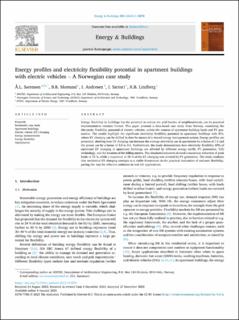| dc.contributor.author | Sørensen, Åse Lekang | |
| dc.contributor.author | Morsund, B.B. | |
| dc.contributor.author | Andresen, Inger | |
| dc.contributor.author | Sartori, Igor | |
| dc.contributor.author | Lindberg, Karen Byskov | |
| dc.date.accessioned | 2024-01-10T06:42:52Z | |
| dc.date.available | 2024-01-10T06:42:52Z | |
| dc.date.created | 2024-01-05T08:08:38Z | |
| dc.date.issued | 2024 | |
| dc.identifier.issn | 0378-7788 | |
| dc.identifier.uri | https://hdl.handle.net/11250/3110768 | |
| dc.description.abstract | Energy flexibility in buildings has the potential to reduce the grid burden of neighbourhoods, yet its practical implementation remains limited. This paper presents a data-based case study from Norway, examining the electricity flexibility potential of electric vehicles, within the context of apartment building loads and PV generation. The results highlight the significant electricity flexibility potential in apartment buildings with EVs, where EV charging can be shifted in time by means of a shared energy management system. Energy profiles are presented, showing how EV charging can increase the average electricity use in apartments by a factor of 1.5 and the power use by a factor of 3.5 to 8.6. Furthermore, the study demonstrates how electricity flexibility KPIs of optimised EV charging in apartment buildings are affected by different energy tariffs, PV generation, V2G technology, and the location of the billing meters. The simulated scenarios showed a maximum reduction of peak loads of 45 %, while a maximum of 38 % of the EV charging was covered by PV generation. The study confirms that residential EV charging emerges as a viable frontrunner in the practical realization of end-user flexibility, paving the way for effective solutions in real-life applications. | en_US |
| dc.language.iso | eng | en_US |
| dc.publisher | Elsevier | en_US |
| dc.subject | Residential case study | en_US |
| dc.subject | Apartment buildings | en_US |
| dc.subject | Electric vehicle (EV) charging | en_US |
| dc.subject | Energy measurements | en_US |
| dc.subject | Energy flexibility | en_US |
| dc.subject | Optimisation | en_US |
| dc.title | Energy profiles and electricity flexibility potential in apartment buildings with electric vehicles – A Norwegian case study | en_US |
| dc.type | Peer reviewed | en_US |
| dc.type | Journal article | en_US |
| dc.description.version | publishedVersion | en_US |
| dc.rights.holder | © 2023 The Author(s). | en_US |
| dc.source.volume | 305 | en_US |
| dc.source.journal | Energy and Buildings | en_US |
| dc.identifier.doi | 10.1016/j.enbuild.2023.113878 | |
| dc.identifier.cristin | 2221003 | |
| dc.relation.project | Norges forskningsråd: 272402 | en_US |
| dc.relation.project | Norges forskningsråd: 326891 | en_US |
| dc.relation.project | Norges forskningsråd: 257660 | en_US |
| dc.source.articlenumber | 113878 | en_US |
| cristin.ispublished | true | |
| cristin.fulltext | original | |
| cristin.qualitycode | 2 | |
